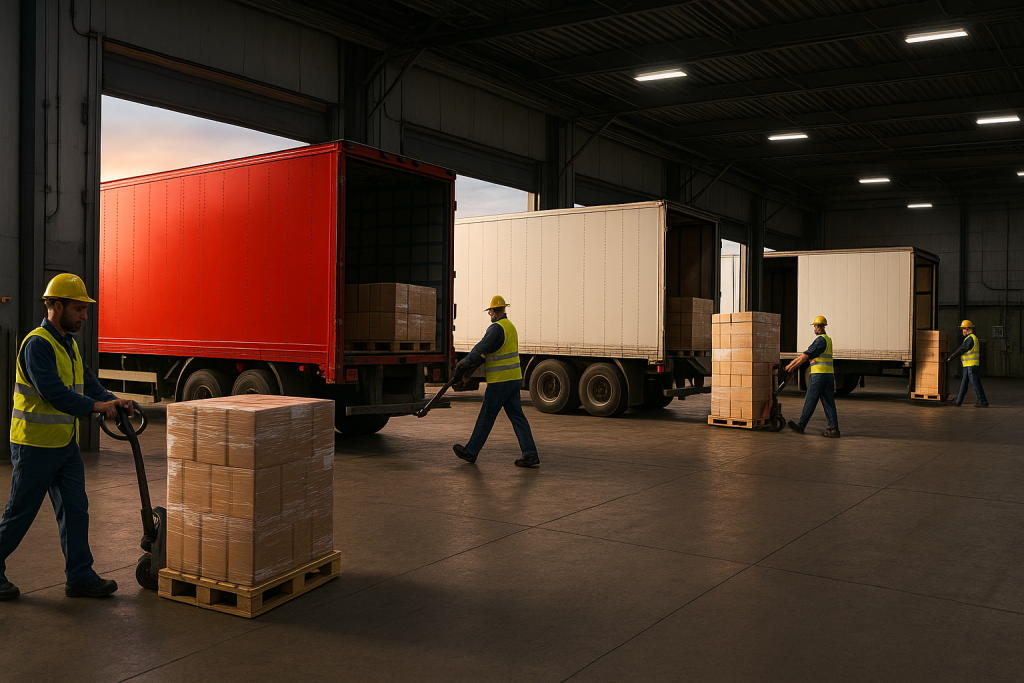By Martin Vassilev / 18 Sep, 2025
In today’s competitive logistics environment, businesses in Calgary and Seattle are facing unprecedented challenges when it comes to meeting customer expectations, reducing costs, and improving delivery speed. One solution that has gained significant traction is cross-docking—a streamlined distribution strategy that minimizes storage time by moving products directly from inbound shipments to outbound transportation. For companies in these growing metropolitan hubs, cross-docking has become not just a cost-saving tactic but a critical driver of efficiency and customer satisfaction.
Cross-docking is a logistics practice where incoming goods are unloaded from supplier trucks, sorted, and immediately reloaded onto outbound trucks for delivery. Unlike traditional warehousing, which relies heavily on long-term storage, cross-docking focuses on speed, precision, and reduced handling.
Minimized Storage Costs: Goods spend less time in the warehouse, reducing overhead.
Faster Turnaround: Orders reach end customers more quickly.
Improved Supply Chain Visibility: Real-time tracking of products in transit optimizes delivery schedules.
This model is particularly advantageous for industries handling high-volume, time-sensitive, or perishable products, making Calgary and Seattle prime markets for its adoption.
Calgary has long been recognized as a transportation and logistics hub in Western Canada. With its strategic location near major highways and rail networks, cross-docking is a natural fit for businesses looking to:
Reduce Freight Costs
By eliminating unnecessary storage, companies can consolidate shipments, lower handling fees, and avoid high warehousing expenses. Calgary companies are increasingly pairing cross-dock services with warehouse efficiency strategies to keep operations lean.
Support E-Commerce Growth
The rise of e-commerce has created a demand for faster last-mile delivery. Cross-docking helps businesses meet customer expectations for same-day or next-day delivery without excessive warehousing.
Adapt to Seasonal Demand
Calgary’s diverse economy—from energy to retail—often faces fluctuating demand. Cross-docking allows businesses to scale up or down efficiently, particularly during holiday seasons or energy sector surges.
Seattle, as a Pacific Northwest trade powerhouse, benefits from its proximity to ports, international shipping routes, and major U.S. retailers. Cross-docking is increasingly being adopted for reasons including:
Port-Centric Distribution
Seattle’s ports receive significant international cargo. Cross-docking enables businesses to bypass long-term storage by moving goods straight to inland destinations.
Meeting Amazon-Era Expectations
With Amazon headquartered in Seattle, local businesses face constant pressure to match ultra-fast delivery standards. Cross-docking provides the agility to compete by cutting fulfillment times.
Sustainability Goals
Seattle’s progressive business culture is focused on reducing carbon emissions. Cross-docking contributes to green logistics by consolidating shipments, reducing fuel consumption, and minimizing unnecessary warehouse storage. Companies can also integrate cross-docking with green logistics strategies to meet ESG commitments.
Both Calgary and Seattle companies in retail sectors rely on cross-docking to meet fluctuating consumer demands. By skipping storage, retailers can respond to inventory surges quickly, ensuring stores remain stocked.
Cross-docking is particularly critical for perishable goods. Fresh produce arriving at Seattle ports or Calgary suppliers can be moved directly to grocery chains, ensuring freshness and reducing waste.
Manufacturers benefit from synchronized deliveries of raw materials. Cross-docking ensures production lines remain uninterrupted, lowering downtime and operational delays.
Cross-docking eliminates delays caused by warehousing, giving companies the ability to move products to shelves or customers faster. In a competitive retail environment, this speed often translates into higher customer loyalty.
Businesses in both cities face rising warehousing costs. Cross-docking helps them avoid unnecessary storage expenses and allocate capital toward more strategic areas such as supply chain optimization.
The fewer times a product is touched, the lower the chance of damage. Cross-docking improves customer satisfaction by ensuring items arrive in pristine condition.
Cross-docking operations can easily be scaled up during peak seasons and scaled down during slower periods, giving businesses flexibility without long-term commitments to warehouse leases.

Technology is a critical enabler of modern cross-dock operations. Advanced AI-driven logistics tools and real-time tracking systems ensure precision, accuracy, and accountability. Businesses in both Calgary and Seattle are turning to AI in logistics to forecast demand, optimize truck routing, and improve warehouse flow.
RFID & Barcode Systems: Enable accurate inventory scanning at dock points.
Transportation Management Systems (TMS): Improve carrier coordination.
Data Analytics: Provides insights into peak demand, bottlenecks, and efficiency gaps.
While highly beneficial, cross-docking comes with challenges:
High Initial Setup Costs: Facilities need proper dock designs, automation, and tracking systems.
Coordination Complexity: Timing of inbound and outbound shipments must be tightly synchronized.
Skilled Workforce Demand: Employees require training to manage rapid sorting and loading processes.
Businesses that fail to manage these aspects risk inefficiencies that outweigh cross-docking’s benefits. For insights into avoiding such pitfalls, companies often study industry warehousing case studies.
Sustainability is no longer optional. By reducing warehouse footprints and consolidating deliveries, cross-docking directly supports eco-friendly goals. According to the U.S. Environmental Protection Agency (EPA), optimized freight systems can significantly reduce greenhouse gas emissions and fuel consumption (source).
Similarly, Canadian businesses in Calgary can leverage government resources on efficient logistics provided by Transport Canada (source) to enhance their sustainable supply chain practices.
Looking ahead, cross-docking is poised for further expansion across both cities:
E-Commerce Surge: Consumer demand for instant delivery will continue fueling adoption.
AI & Automation: Smarter warehouses and predictive systems will reduce errors and streamline dock operations.
Global Trade Growth: With Seattle’s port activity and Calgary’s role as a Western Canada hub, cross-docking will remain vital in managing international shipments.
For companies seeking to future-proof operations, integrating cross-docking with warehouse automation strategies and sustainable logistics practices will deliver long-term competitive advantage.
Cross-docking is no longer an optional strategy; it is becoming an essential component of efficient logistics in both Calgary and Seattle. From cost savings to sustainability, it delivers advantages that align with modern supply chain demands. Businesses embracing this model are better positioned to meet customer expectations, scale operations, and maintain profitability in competitive markets.
For companies looking to implement or enhance cross-docking strategies, partnering with a logistics provider that understands the nuances of both Canadian and U.S. markets is key. Explore ByExpress’s contact page to discuss tailored cross-dock and fulfillment solutions.

“Thanks to Byexpress all my shipping and fulfillment costs are in line now”

“All my issues were solved by Byexpress team that I had with pervious 3pl provider.”

“Thank you Byexpress team could not done it without you guys.”

“Their integration and customer service were the key for me”

“Outstanding delivery service! The package was well-packaged, and
the delivery team was professional and courteous”

“Great and knowledgeable team to work with.”

Thanks, guys, for reducing my shipping rates
Ottawa Office
2411 Holly Lane
Ottawa, ON, K1V 7P2
Toronto Office
13-280 West Beaver Creek Road Unit #136
Richmond Hill, ON, L4B 3Z1
Alexandria Office
173 Kenyon Street West
Alexandria, ON, K0C 1A0
Montreal Office
4388 Saint-Denis Street Unit #200
Montreal, QC, H2J 2L1
California Office
155 North Riverview Drive
Anaheim Hills, CA, 92808
Call Us
Toll-Free: 1-866-744-7122
Local : 613-739-3000
Email Us
Multilingual Services










